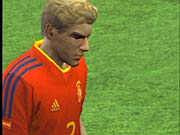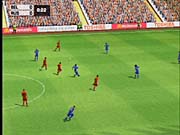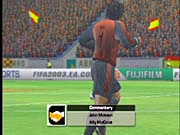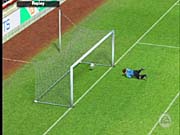Last year, EA Sports made substantial changes to its FIFA series with FIFA 2002. The game generally slowed down the series' gameplay and made it much more difficult to execute complex plays, and as a result, it was probably the closest the FIFA series had ever come to simulating the sport of professional soccer. EA is looking to build on that success with FIFA 2003, which surpasses the previous installment in terms of the authenticity of its simulation of the sport. In FIFA 2003, your offense must run a coordinated attack that draws careless defenders in toward the ball, thus leaving teammates open down the field--even against the worst international teams, pushing the ball straight up the field with only a few players isn't an effective strategy and will almost always result in an interception. Even further, other gameplay mechanics that were relatively straightforward in previous FIFA games, such as corner and penalty kicks, now have a greater level of depth, and juke moves are now performed using EA Sports' freestyle control system. As such, FIFA 2003 is an excellent game that will appeal to any soccer fan who prefers realism to the fast-paced, high-scoring style of other soccer games.

The different gameplay modes in FIFA 2003 aren't all that different from those in previous FIFA games. In the club championship mode, you can play a club championship friendly (the equivalent of an exhibition match), or you can play a club championship season, in which the best club teams vie for the championship trophy. Of course, there's also a basic friendly option in which you can select from dozens of different club and international teams and then jump right into a match. Similarly, if you want a trophy but don't feel like bothering with a season, you can jump right into FIFA 2003's tournament mode, where you can choose to participate in one of six tournaments or create your own to participate in. While these modes will undoubtedly draw the interest of both hard-core and casual soccer fans, the real heart of FIFA 2003 lies in its season mode.
In this mode, you can take control of a team from one of 14 leagues, including Major League Soccer, the Italian League, the FA Premier League, Spanish Primera Division, and others. Once a league has been selected, you can choose one of the teams from within that league and take it through an entire season in the hope of winning championships. It's worth noting that there are minor differences between a few of the leagues. For example, most of the European leagues have to worry about cup and divisional matches, while in the MLS, none of these things exist.

But regardless of the league, you'll still have the same sort of options to select from before jumping into an actual game. You can view the team standings, have a look at your schedule, and simulate the outcome of any upcoming games. In the team management option, you can view individual player skill levels, set formations, and determine who takes free kicks, corner kicks on both sides of the field, and spot kicks. Lastly, you can also buy and sell players, but you won't be limited to players within your league, so if your team has enough cash, you can certainly go after one of the top international players. The season mode is pretty interesting, and most fans will find it entertaining going from season to season, but it's not exactly an in-depth look into what goes on behind the scenes in professional soccer leagues and in the offices of the people who control the teams.
For most, the gameplay in FIFA 2003 will make up for any shortcomings in its secondary features, because it's simply incredible. The single most important aspect of the gameplay in FIFA 2003 is teamwork--without it, your opponent will always end up with the ball. You always have to be aware of teammates and plan your offensive strategy according to where they are in relation to defenders. For example, if you drive the ball up the middle of the field, then you'll probably draw defenders from the wings, allowing you to perform a ground or lob pass to an open teammate at the edge of the field. When you push the ball up with that player, the objective is to draw more defenders and find another open man, but if it looks like you have the opportunity, you can also hit the sprint button and drive the ball up the field a little more before passing off to a teammate.
Obviously, passing plays an important role here, and thankfully, it can be quite easy to have a precise passing game in FIFA 2003. Computer-controlled players like to stand in the passing lanes of players who are up the field, so they'll usually intercept the ball if you try to push it past them. Lob passes or even crosses can be useful these types of situations, especially when the teammate you're passing to is close to the goal, but it can be difficult to execute one of these passes properly if a defender is directly on the player with the ball. Since the strength of the pass (indicated by a meter below the player's name) is determined by how long you wait to tap the pass button a second time, you essentially give the defender more time to react if you're trying to kick the ball across the field. But if performed correctly, a pass to a teammate in front of the goal can have a variety of different results, ranging from headers and bicycle kicks to a teammate intercepting the pass with his chest, getting the ball on the on the ground, and then taking a shot.

The passing system hasn't been changed dramatically, but EA Sports made some changes to the corner kick and penalty kick system. Instead of using a gigantic arrow to depict where the ball will land on a corner or penalty kicks, FIFA 2003 uses a new system in which your accuracy depends on your ability to stop a small moving cursor as close as possible to a certain area of the new kick accuracy meter. The direction of the kick will depend directly on where your foot strikes the ball, and you can choose to hit any portion of the ball by adjusting a cursor on the ball icon that appears at the bottom of the screen. This might seem like a straightforward idea, but it can actually take some time before you fully understand the mechanics and discover the combinations of accuracy and kick placement that work well in particular situations. Shooting has been left virtually unchanged, but it seems the accuracy has been tweaked so that a shot on goal doesn't always mean it will magically come anywhere near the goal.
The juking system on the offensive side of the ball has been also changed. Performing juke moves is accomplished using the freestyle control system, which is supposed to give you more control over your ball fakes and generally bring you further into the game. Unfortunately, the freestyle control in FIFA isn't all that free--so many moves depend on what your player is doing at the time that he'll end up doing nothing because you didn't use the correct directional combination for that situation. The system also depends on which foot he's using to control the ball, so there's a lot of a little things that you need to pay attention to. After a while, you'll start to get a feel for a few of the different moves that you can execute using the freestyle system, but there's no question that it's not even remotely as free-flowing or smooth as the freestyle controls used in EA's NBA Live series.
On the defensive side of the ball, there haven't been quite as many changes. You can perform the standard slide tackle, which will usually result in a foul if you're not careful, as well as a challenge that simply involves running up to the player with the ball and attempting to take it away from him. The goalie AI is generally very good and will rarely make any mistakes that the goalies in the actual sport don't make. The keeper will run out to grab or even challenge the ball if no other offensive players are in the vicinity. He'll also punch out lobs or crosses and quickly reach out his hand to cover the ball even when a shot that has absolutely no chance of making it into the goal goes flying by.
The PlayStation 2 version of FIFA 2003 looks similar to 2002 FIFA World Cup, but there are a few minor differences. The player faces seem a little more realistic and generally a little smoother than those in the previous games. The player animation is also very good and seems to fit a little more naturally with the on-field action. The numerous stadiums in the game look absolutely amazing, as do the lively crowds that inhabit them. You'll see all sorts of cool little details, from flags waving in the crowd to fireworks to officials running along the sidelines.

The sound is probably the only disappointing aspect of FIFA 2003's presentation. The commentary isn't horrible, but like in last two FIFA games, the play-by-play man and color commentator don't interact with each other all that much, and their comments don't sound very natural. However, the stadium noise is incredible, with team-specific chants in some stadiums and some chatter on the field. It's definitely worth turning down the commentary so you can soak up the atmosphere of a professional soccer match.
FIFA 2003 for the PlayStation 2 is probably the most accurate representation of professional soccer to date, which might intimidate more-casual fans of the sport. While the game does feature an arcade mode in which the speed is turned up and most of the rules aren't enforced, the same basic strategies that you would use in the simulation option still apply. In any case, if you're looking for the best simulation of professional soccer to date, then you needn't look further than FIFA 2003.